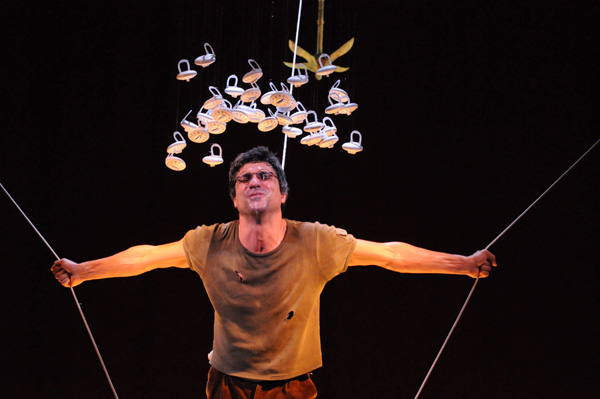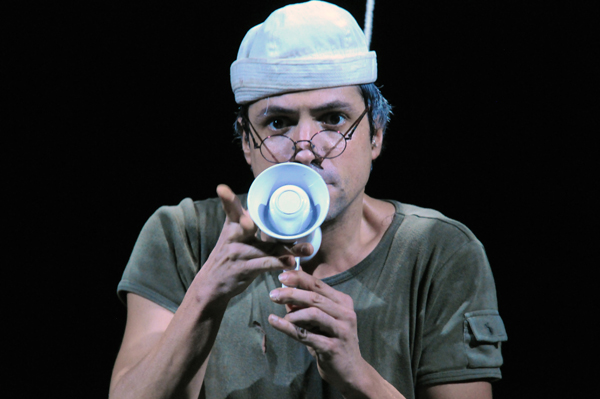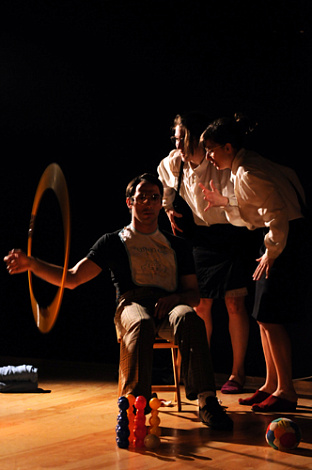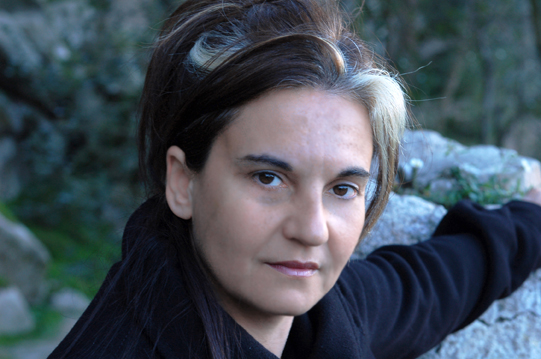First night – January, 15, 2011, Naples
We just want to talk of what we are, of what is inside us, of what destroys us and fills us with contradictions. These contradictions we carry with us all the time - common sense and senselessness, power and powerlessness. If I had been asked to express my idea of theatre I would have said this: a situation brings up a feeling and thus stimulates the action. This is what life itself is doing. Theatre is always far ahead of all definitions and meanings.
Emma Dante
The spectacles trilogy consists of three autonomous performances related to each other by the theme of marginality: poverty, old age and ailment. All the characters of the trilogy are wearing glasses; all of them are half-blind, melancholic and forlorn.
Part One. Holy Water
The production about the poor, ailing and aging people is visually striking and abounding in meanings. The Carmine lines in the prow of Carmine’s boat are rocking while the performer is key-framed by the cables. And the monologue of the sailor who was posted from the ship is also strikingly pictorial: ‘I saw a harlequin octopus – his tentacles were tinctured in all the colors of the rainbow… Tropical fishes were dancing around him… And Christ in Rio – I saw him too. He was diving from the Corcovado Mountain, his hands spread wide apart’. ‘Dante’s people’ are by no means pathetic. The theatre converts the old man’s anguish about the sea that was taken away from him into an ode to the world that eyes can see; a thanksgiving song to the reefs, the sunrays, the icebergs, the galleons and the fish.
Novaya Gazeta
Part Two. The Zisa Castle
The second performance, The Zisa Castle, is named after the catholic asylum for incurable patients. Its sisters of mercy, the nuns, are infantile and inquisitive, cantankerous and superstitious… But there is something bigger in their troubling over the incurable autist Nicola. The audience shudders when the old spinsters are hitting the motionless body with a gymnastic ball. Or when a hoop is put on the sick man’s arm and it keeps falling and clattering over and over again. And when the sick man finally loses his balance and collapses on the floor.
But at some point the catharsis occurs. It is spelled without words but in the body language. The hoop on the arm of the immobilized man quivers once, then once again… and starts revolving… This rotary movement builds up as the nuns, perplexed, are watching it, powerless to take in the miracle of recuperation.
But in the finale episode ‘the miracle of recuperation’ will turn out merely the sick man’s dream.
The message of Emma Dante’s previous stagings was that life is an endless suffering and man is doomed to take it and there is no one to be made answerable for this. Her and her theatre’s relationships with God have always been very tense and the dénouement would invariably be a monologue of wrathful negation.
But in the Spectacles Trilogy the language of movements most powerfully affirms that miracles do happen.
Novaya Gazeta
Part Three. The Ballarini
During intermissions lurking among visitors are two ghostly figures. They are obviously very old and their physique unambiguously betrays flagging strength. Their wigs are grey and their masks are strewed with ‘buckwheat’ of senility. He and She are tangoing across the foyer.
These are the personages of Part Three, the Ballarini couple. Or rather it is the widow and her late husband’s ghost.
She takes out a jacket and irons the threadbare tweed with such strength that the ghost of him scrambles out from a trunk. The dance of the ninety-year-olds is so expressive and so clearly underscores the choreographic difference between the male and female partners that the senility and the masks slide off both of them. Presently twisting on the stage are the newlyweds of the 1950-s.
This is an ode to love that will also turn out to be only a dream. And this is probably the most powerful scene of the entire performance.
Novaya Gazeta






